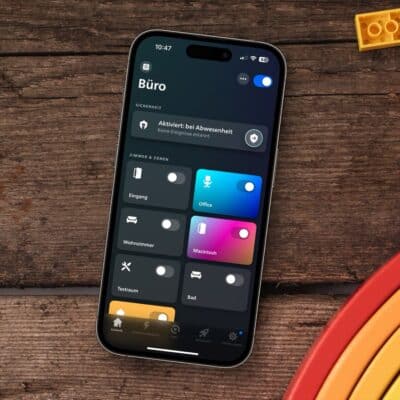The Philips Hue Play Gradient Light Tube is actually intended for installation under a TV that is already equipped with a Play Gradient Light Strip on the other three sides. However, the smart tube is versatile and also cuts a fine figure in the bedroom, for example. We’ve been using it in our son’s nursery since we switched to a new bed (again).
Together with a Hue Smart Button, which we have attached to the headboard of the bed, the Hue Play Gradient Light Tube fulfils four functions at once. It is a mood light, a night light, a reading light and can be used for indirect lighting.
Unfortunately, I don’t have any pictures of the tube, which is available in two different lengths, being installed. Regardless of whether you use the compact 87.7 centimetre long version or, like me, the 137.7 centimetre long tube, installation is not a major challenge. You can unscrew the wall bracket at both ends using the hexagon socket spanner supplied. This is fixed to the wall with a screw and the Hue Play Gradient Light Tube is then simply put back on and tightened.
The Hue Play Gradient Light Tube fulfils these four functions
Night light: The tube can be rotated almost 360 degrees. Aligned to the wall, with a light red colour and low brightness, we use it as a night light.
Reading light: With the reading scene and adjusted brightness, the Hue Play Gradient Light Tube serves as a reading light. In this case, we point the LEDs towards the bed.
Indirect lighting: If the large ceiling light is switched off, the Hue Play Gradient Light Tube can shine a bright scene towards the ceiling and discreetly illuminate the room with its 1,800 lumens.
Mood lighting: In combination with the ceiling lighting, we also switch on the Hue Play Gradient Light Tube with the Hue wall switch module and use it as mood lighting with a colour gradient.
Philips Hue Play Gradient Light Tube
$219.99 / £189.99 / €219,99
Note: This article contains affiliate links. We receive a commission for purchases via these links, which we use to finance this blog. The purchase price remains unchanged for you.
































I had a similar thought, that this product looks useful for many more purposes than lighting a wall behind a TV.
In California, most houses are built with gas fireplaces, because it is thought to raise the value of the house (the many problems resulting from treating houses as an investment is a whole other story…). Such fireplaces are expensive to operate, contribute to climate change and poor air quality, allow drafts into the house even when not in use, often have inconvenient placement that prevents proper arrangement of the TV or furniture, etc. Basically, they are a nuisance, but it is almost impossible to find a house without one. We eventually settled for a house that has one in a minimally annoying place, but it still bothers me.
A while ago I went to a number of fireplace showrooms to inquire about electric fireplaces. I was entirely unimpressed by their offerings. It would have been absurdly expensive to remove my gas fireplace and install an electric, and the salespeople could barely hide their contempt for the electric version. But worst of all, the lighting effect is far worse (more primitive, and unconvincing) compared to what I already have with my Philips Hue lights. It seemed like a complete waste of time and money, so I did not proceed.
Instead, I went on Etsy and found a carpenter who could build a custom wooden covering for my gas fireplace (to keep out drafts). Painted in a neutral white color, and with a Hue Play Gradient Light Tube attached near the bottom, I am hoping that the Hue app’s “Fireplace” effect will serve as a nice replacement for burning gas fuel in the actual fireplace. I am still eagerly waiting for the carpenter to finish and ship the covering, and I have the Hue Tube ready for when it arrives. By coincidence, the “compact” Tube is almost the exact width of my fireplace.
One final thought… Hue products are often criticized for being expensive. (I think it is worth it for the Hue Scene Gallery alone, which is far better than any of the competition, in my opinion.) In any case, for the price of a single electric fireplace, you could easily outfit every room in your house with Hue products. I think the price seems a bit more reasonable, in light of that.
The website says it requires a bridge (which of course it does) but also the sync box, which I still refuse to buy until they update the specs for hdmi 2.1…
I’m assuming based on your post that the sync box would only be required if you wanted to use it in conjunction with syncing your tv with your lights?
That’s correct. It’s just a normal Hue light, when you don’t use it with the Sync Box.
I really wish somebody would make a decision Tree when it comes to purchasing these and keep it simple. Knowing which version of a light stick or a sink box or a bloom or the duel tubes behind a computer….
Talk about a headache. I don’t even understand why anybody would buy little lamps for 200+ when you could just buy a bulb for a regular lamp
Then trying to figure out which models would work with what as you grow out your system even on the official site, an opportunity for somebody